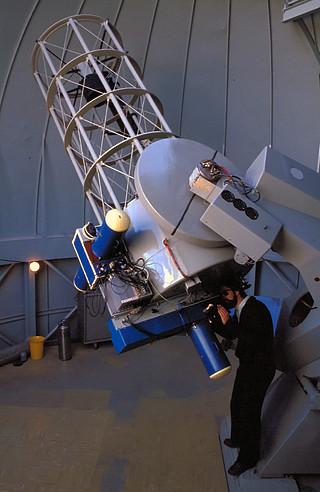Walraven Photometer (decommissioned)
 The Walraven Photometer was designed by Theodore Walraven at Leiden Observatory in the Netherlands, and mounted at the Cassegrain focus of the 36-inch photometric telescope known as the “Lightcollector”, located at the Leiden Southern Station in South Africa in 1958.
The Walraven Photometer was designed by Theodore Walraven at Leiden Observatory in the Netherlands, and mounted at the Cassegrain focus of the 36-inch photometric telescope known as the “Lightcollector”, located at the Leiden Southern Station in South Africa in 1958.
In 1978 the Leiden Observatory Foundation (LUF) and ESO struck an agreement to move the telescope to ESO’s La Silla Observatory, sharing it equally. The Walraven Photometer was flown back to the Netherlands for long-needed modifications, and the telescope was shipped directly to Chile, seeing first light again in March 1979. After moving to La Silla the “Lightcollector” became known as the Dutch 0.9-metre telescope.
The Walraven Photometer, which had been fully integrated and built around the telescope for greater stability, was modified in such a way that its lower part became detachable. This allowed access to the Cassegrain focus, also to visitor instruments, without affecting its stability.
Making use of a clever polarisation optics filter, which provided the possibility to measure simultaneously in five photometric bands, the Walraven Photometer was originally designed with the purpose of studying early-type stars. As it turned out, the location of the photometric passbands also made it very useful for the classification and study of physical parameters of A, F and G stars. Between South Africa and Chile the Walraven Photometer was used to study OB stars in the Milky Way Galaxy and the Magellanic Clouds, Pulsating variables such as Cepheids and RR Lyrae stars, stellar metallicity, OB associations as well as cataclysmic and X-ray variables — all because of its near ultraviolet sensitivity.
The Walraven Photometer played an important role in data collection for the preparation of ESA's HIPPARCOS satellite.
In 1987 the Walraven Photometer was used in photometric measurements of SN 1987A, to monitor the energy distribution of the supernova in near ultraviolet (eso8704).
Due to its unique design, the Walraven Photometer was highly stable and time-efficient, due to the possibility of using 5 simultaneous channels. Its photometric system measured light from the visible to the near ultraviolet, with passbands at the effective wavelengths of 542 nm (V), 427 nm (B), 385 nm (L), 362 nm (U) and 323 nm (W). For this reason it is also known as the Walraven VBLUW Photometer.
The Walraven Photometer was decommissioned from the Dutch 0.9-metre telescope in 1991. After 2006 it was returned to Leiden and it is now in the Boerhaave Museum for the History of Science.
Walraven Photometer at the Dutch 0.9-metre telescopeThis table lists the global capabilities of the instrument.
|